Hello Art of Inclusion readers!
I just wanted to let you all know that I am finally taking action to stop the problem that has cropped up in the blog comments section with spam-poetry such as this:
and this:
and super flattering spam like this one:
I've turned on the "Word Verification" feature, which will make it a tiny bit more time consuming for folks to leave comments on the blog, but should hopefully mean that you all no longer have to receive weird spammy emails every time you leave a comment.
Saturday, December 22, 2012
Monday, December 17, 2012
Artist Interview with Sue Reno
I was recently fortunate to participate in Art Quilts XVII: Integrating the Paradox alongside many excellent art quilters, and the fabulously talented Sue Reno agreed to set aside some time to answer a collection of questions for my first ever Artist Interview here on the blog! I think you will find both my questions and Sue's answers quite intriguing (I know I gained a new understanding of Sue's work from her answers, plus some thoughts about how to relate to my own), so I definitely encourage you to read on!
Do you have a specific idea of the story you'd like each piece to tell, or are you hoping viewers will have stories of their own ready to inhabit your work?
Both! I consider myself primarily a storyteller, and each piece gets created in response to an experience I’ve had, generally an interaction with the natural world. I spend as much time as possible outdoors, walking around looking at things in nature, or attempting to tweak the micro environment in my yard. I also spend time in and around the historic architecture so prevalent here in Lancaster County, PA. From time to time something about a leaf, or an animal skull, or a building will become so compelling that I need to drop everything and produce work that reflects my understanding of it. But I also try to not be too heavy handed, to leave room for the viewer to bring their own interpretation and their own personal history to the piece.
Would you say that there is some particular thing that you are channeling while you work? How would you describe that something?
When things are going swimmingly, and I am in a state of flow, I would describe it as the deliberate practice of getting out of my own way. My conscious self can take things only so far, in terms of scheduling some time, and obtaining materials, and roughing out a scheme, but then it’s time to step aside and let the subconscious have a turn at the wheel.
Would you say your personal style runs more towards clutter or organization? Does your style work for you, or are there elements of it you wish you could change?
I need to work in an organized and calm space. I carry in my head a detailed inventory of all the fabric I’ve ever bought or otherwise acquired and I need to be able to find a specific piece of fabric quickly and easily. All my fabrics and other materials are sorted, labeled, and shelved in clear bins. That being said, I am not afraid to make a mess while I am working and in the flow, and I am open to serendipitous combinations that emerge from the temporary chaos. But I clean it all up when I am done with a project before moving on the next.
Are you a stickler about your particular medium, or are you happy to cheat, borrow and steal from other disciplines whenever it seems like a good idea?
Within my chosen medium of fiber art / art quilting, I have several surface design techniques that I return to time and again—cyanotype, heliographic printing, thermofax screen printing, and digital transfer. Each time I employ them, I discover new things, and increase my knowledge base and control of the process. So while I am not opposed to an influx of new ideas, techniques and materials, I feel like I am still just scratching the surface of what can be done with the ones I currently employ. You could say I am going for depth rather than breadth.
Do you ever have to choose between doing some aspect of your work "the lazy way" versus "the better but far more annoying way," and has going for "the lazy way" ever produced unexpectedly awesome results?
I am not a big fan of the “lazy” or easy path. I am meticulous in my craft practice and will do whatever is needed to meet my self-imposed standards. I try not to rush any part of the process, and to enjoy it as it unfolds.
My quilts are pieced, not fused, because I can only get the type of texture and integration of materials, and the aesthetic I prefer, by stitching the elements together. (This is not a prejudice against fused work in general—it’s just my personal preference.) So I don’t mind that the piecing is time consuming; same with the quilting stitches, or the hand embroidery, or the bead work. All of the detail work provides a reward to the viewer who steps up for a closer look at the piece.
I also am always mindful of the ways in which I can extend the expected archival life of my work, and am leery of shortcuts that could jeopardize it. So in general I stick with traditional and time tested materials and methods. They provide the backbone for a design aesthetic that is decidedly not traditional, and I enjoy the juxtaposition and dialogue that results.
Describe your sketchbook (or other Vital Idea Capturing Apparatus). Do you work in such a way that there is a great distance between sketches and finished projects, or are you more likely to incorporate your sketches directly into your final work?
I don’t use a sketchbook or similar device. I work on images and ideas (there’s never a shortage) in my head, and I feel like if I can’t remember them, they are not worthwhile. I do enjoy documenting a project as I go along, taking pictures and keeping swatches and so on, but that’s the other end of the process. The times I have tried to sketch or excessively plan out a work, I’ve lost interest in it. If I’ve already designed it, where’s the mystery and the excitement in seeing how it takes form?
Are there any colors that give you particular trouble?
Nope, I love them all! And I’m not shy about combining them. I hate color wheels; I feel they put an unnecessary layer of bureaucracy between the colors and my use and enjoyment of them. I do use discretion, and hopefully I have taste and judgment, but I will not be dictated to by external standards of what “goes” together. And if I am ever in doubt, I just look to the natural world.
Do you have any concrete advice about how to do away with artist's block?
Relax. Don’t panic. Breathe deeply. Go for a bike ride. Walk in the woods. Have a beer. Eat some raspberries. Dabble in an alternative craft/art practice. Do the things that make you happy, and don’t worry. Creativity springs from an endless well, and dry spells will pass.
This summer I took my own advice and bought a set of specialty lenses for my iPhone. I have been having an absolutely fabulous time experimenting with macro and fisheye photography, and I am learning a great deal about the natural world and what makes a good image. I don’t know where this is leading in regards to my fiber work, but it’s bound to be a good thing.
You live in Pennsylvania - what opportunities exist locally for fiber artists? What about the character of your city do you find particularly inspirational? Are there any local organizations or groups you'd like to mention so they can get more exposure?
I am fortunate to be involved in several excellent local artists’ organizations. The Pennsylvania Arts Experience is a diverse group of incredibly talented artists working in a variety of mediums, and I’m proud to have been a part of the organization since its inception. It’s provided me with exhibit opportunities and the opportunity to forge some wonderful friendships. Do yourself a favor and browse the artist galleries:
http://www.paartsexperience.com/
I’ve also a member of the Pennsylvania Guild of Craftsmen, which recently opened its flagship store here in Lancaster. I’ve obtained juried status with the organization, and volunteer my time serving on the Standards Committee and doing floor jurying. I’ve learned a tremendous amount about craft practice and met some amazing artists through my participation. Read all about it here:
http://www.pacrafts.org/
Thank you so much Sue Reno for your excellent answers - I definitely hope you'll have a show here in NYC some time so I can see your work in person and do a review on the blog!
 |
| "Bamboo Emerging" by Sue Reno |
Both! I consider myself primarily a storyteller, and each piece gets created in response to an experience I’ve had, generally an interaction with the natural world. I spend as much time as possible outdoors, walking around looking at things in nature, or attempting to tweak the micro environment in my yard. I also spend time in and around the historic architecture so prevalent here in Lancaster County, PA. From time to time something about a leaf, or an animal skull, or a building will become so compelling that I need to drop everything and produce work that reflects my understanding of it. But I also try to not be too heavy handed, to leave room for the viewer to bring their own interpretation and their own personal history to the piece.
 |
| "Ginger" by Sue Reno |
Would you say that there is some particular thing that you are channeling while you work? How would you describe that something?
When things are going swimmingly, and I am in a state of flow, I would describe it as the deliberate practice of getting out of my own way. My conscious self can take things only so far, in terms of scheduling some time, and obtaining materials, and roughing out a scheme, but then it’s time to step aside and let the subconscious have a turn at the wheel.
 |
| "Silk Mill #1" by Sue Reno |
Would you say your personal style runs more towards clutter or organization? Does your style work for you, or are there elements of it you wish you could change?
I need to work in an organized and calm space. I carry in my head a detailed inventory of all the fabric I’ve ever bought or otherwise acquired and I need to be able to find a specific piece of fabric quickly and easily. All my fabrics and other materials are sorted, labeled, and shelved in clear bins. That being said, I am not afraid to make a mess while I am working and in the flow, and I am open to serendipitous combinations that emerge from the temporary chaos. But I clean it all up when I am done with a project before moving on the next.
 |
| "Columbine" by Sue Reno |
Are you a stickler about your particular medium, or are you happy to cheat, borrow and steal from other disciplines whenever it seems like a good idea?
Within my chosen medium of fiber art / art quilting, I have several surface design techniques that I return to time and again—cyanotype, heliographic printing, thermofax screen printing, and digital transfer. Each time I employ them, I discover new things, and increase my knowledge base and control of the process. So while I am not opposed to an influx of new ideas, techniques and materials, I feel like I am still just scratching the surface of what can be done with the ones I currently employ. You could say I am going for depth rather than breadth.
 |
| "Plume Poppy" by Sue Reno |
Do you ever have to choose between doing some aspect of your work "the lazy way" versus "the better but far more annoying way," and has going for "the lazy way" ever produced unexpectedly awesome results?
I am not a big fan of the “lazy” or easy path. I am meticulous in my craft practice and will do whatever is needed to meet my self-imposed standards. I try not to rush any part of the process, and to enjoy it as it unfolds.
My quilts are pieced, not fused, because I can only get the type of texture and integration of materials, and the aesthetic I prefer, by stitching the elements together. (This is not a prejudice against fused work in general—it’s just my personal preference.) So I don’t mind that the piecing is time consuming; same with the quilting stitches, or the hand embroidery, or the bead work. All of the detail work provides a reward to the viewer who steps up for a closer look at the piece.
I also am always mindful of the ways in which I can extend the expected archival life of my work, and am leery of shortcuts that could jeopardize it. So in general I stick with traditional and time tested materials and methods. They provide the backbone for a design aesthetic that is decidedly not traditional, and I enjoy the juxtaposition and dialogue that results.
 |
| "The Organic Landscape" by Sue Reno |
Describe your sketchbook (or other Vital Idea Capturing Apparatus). Do you work in such a way that there is a great distance between sketches and finished projects, or are you more likely to incorporate your sketches directly into your final work?
I don’t use a sketchbook or similar device. I work on images and ideas (there’s never a shortage) in my head, and I feel like if I can’t remember them, they are not worthwhile. I do enjoy documenting a project as I go along, taking pictures and keeping swatches and so on, but that’s the other end of the process. The times I have tried to sketch or excessively plan out a work, I’ve lost interest in it. If I’ve already designed it, where’s the mystery and the excitement in seeing how it takes form?
 |
| "Watt & Shand #9" by Sue Reno |
Are there any colors that give you particular trouble?
Nope, I love them all! And I’m not shy about combining them. I hate color wheels; I feel they put an unnecessary layer of bureaucracy between the colors and my use and enjoyment of them. I do use discretion, and hopefully I have taste and judgment, but I will not be dictated to by external standards of what “goes” together. And if I am ever in doubt, I just look to the natural world.
 |
| "Skunk and Garlic Mustard" by Sue Reno |
Do you have any concrete advice about how to do away with artist's block?
Relax. Don’t panic. Breathe deeply. Go for a bike ride. Walk in the woods. Have a beer. Eat some raspberries. Dabble in an alternative craft/art practice. Do the things that make you happy, and don’t worry. Creativity springs from an endless well, and dry spells will pass.
This summer I took my own advice and bought a set of specialty lenses for my iPhone. I have been having an absolutely fabulous time experimenting with macro and fisheye photography, and I am learning a great deal about the natural world and what makes a good image. I don’t know where this is leading in regards to my fiber work, but it’s bound to be a good thing.
 |
| "Groundhog and Green Bean" by Sue Reno |
You live in Pennsylvania - what opportunities exist locally for fiber artists? What about the character of your city do you find particularly inspirational? Are there any local organizations or groups you'd like to mention so they can get more exposure?
I am fortunate to be involved in several excellent local artists’ organizations. The Pennsylvania Arts Experience is a diverse group of incredibly talented artists working in a variety of mediums, and I’m proud to have been a part of the organization since its inception. It’s provided me with exhibit opportunities and the opportunity to forge some wonderful friendships. Do yourself a favor and browse the artist galleries:
http://www.paartsexperience.com/
I’ve also a member of the Pennsylvania Guild of Craftsmen, which recently opened its flagship store here in Lancaster. I’ve obtained juried status with the organization, and volunteer my time serving on the Standards Committee and doing floor jurying. I’ve learned a tremendous amount about craft practice and met some amazing artists through my participation. Read all about it here:
http://www.pacrafts.org/
Thank you so much Sue Reno for your excellent answers - I definitely hope you'll have a show here in NYC some time so I can see your work in person and do a review on the blog!
Wednesday, October 24, 2012
Upcoming Show: "Art Quilts XVII: Integrating the Paradox" at Visions Gallery in Chandler, Arizona
This post is coming slightly later than it should, but I have been accepted the show "Art Quilts XVII: Integrating the Paradox," at the Chandler Center for the Arts in Arizona, and I thought I would put up a sampling of works by some of the other artists who will be participating in the show. This show will feature work by many people whose work I admire, either because I already knew who they were and was thrilled to find out I would be in a show with them, or because as I was searching for their names on Google, I was surprised over and over again by the talent of these people I had not known about.
This show promises to be pretty darn fabulous, and I have to say I'm quite sad I won't be able to get out to Chandler to see it in person. If you will be in the area, the works will be on view from November 2, 2012 through January 19, 2013 and you should absolutely check it out (I know, I say this about every show, but it keeps being true!)
Here's the art - some of these are the pieces that will appear in the show, while others are not the ones that will be included, but they should all brighten your day!
And finally, here's my piece:
This show promises to be pretty darn fabulous, and I have to say I'm quite sad I won't be able to get out to Chandler to see it in person. If you will be in the area, the works will be on view from November 2, 2012 through January 19, 2013 and you should absolutely check it out (I know, I say this about every show, but it keeps being true!)
Here's the art - some of these are the pieces that will appear in the show, while others are not the ones that will be included, but they should all brighten your day!
 | |
| "A Rather Attractive Prison," by Pamela Allen |
 |
| "Sketches #3" by Denise Linet |
 |
| "Pair O Docks II" by Betty Hahn |
 |
| "Thought Process 1" by Frances Murphy |
 |
| "Jet in the Carina Nebula" by Jimmy McBride |
 |
| "Voice of Experience" by Kathleen Kastles |
 |
| "Winter's Charms" and "Convergence" by Laura Gaskin |
 |
| "Delhi Commons" by Neera Huckvale |
 |
| "The Poemfish" by Sandra Branjord |
 |
| "Squirrel and Locust" by Sue Reno |
 |
| "Parallax Patterns" by Sandy Donabed |
 |
| "Habitats" by Stella Belikiewicz |
Sunday, September 16, 2012
Art Show: "Line and Color," by Lisa Call at The ArtQuilt Gallery
Once again there is a new show at my favorite venue, The ArtQuilt Gallery in Chelsea, and this time I actually got to go and see the artist speak about her work. The show, titled "Line & Color," will be on view through October 20th, 2012 and features works by Lisa Call, whom I had not previously known a lot about, but I am now a huge fan.
Lisa Call's gallery talk was filled with witty and informative thoughts on all kinds of topics - I'll include a few of my favorite bits from the notes I took, and hopefully my paraphrasing of her words will not be too inaccurate. As always, please forgive the inconsistency in the photos (for a better idea of what Lisa Call's work looks like, go check it out in person!)
One of my favorite things from Lisa Call's talk was her description of her ongoing lack of relationship with what is trendy. As an artist, she is concerned primarily with beauty and compositional integrity, and with achieving a sort of visual rightness, which is a thing that artists are uniquely inclined to seek out. This concern for formal design qualities, along with the fact that Lisa Call does not incorporate any fancy cutting edge technology into her work, has meant that she is not walking a path towards trendiness. This is, I think, true for a fair number of quilt artists, and the thing I took away from Call's talk is that if you approach your work with enough drive and take it seriously enough, you can build a solid career even in the midst of an art world that is not often concerned with the things you care about.
Call's total lack of interest in bringing technology into her work is particularly amusing in light of her job as a software engineer. She's been a part of the computer world for basically forever, and finds that it holds zero interest for her - there is nothing she has to say through her work that cannot be brought about through a series of dyebaths, a twenty year old Pfaff and a massive investment of time. I think nearly all art quilters can appreciate this deliberate decision to embrace slowness in art. Call says the success of her work may indicate that the world is ready to move towards tactile media again as part of a desire to bring beauty back into the world we inhabit.
The process Lisa Call uses to construct her quilts is extremely deliberate, and each step, from designing the work on the wall to cutting, piecing and quilting, involves no shortcuts. As she says, no strip-piecing is involved - if a line is present in a certain spot it is because she specifically meant for it to be there. I have a lot of respect for this way of working, and I enjoy how different it is from my own approach which favors reacting to a work as it develops in real time over careful planning. One area where Lisa Call and I have a similar style, however, is dyeing! Her way of dyeing is in direct contrast to her approach to construction - she uses no formulas, dyes only one yard of fabric at a time, and embraces the "you get what you get" quality that is the result. Brilliant!
Two final thoughts from Lisa Call. The first is her answer to the inevitable question of where the distinction is drawn between functional quilting and Art Quilting. Her response to this is simple and struck me as incredibly true. The answer is Intention. She creates her pieces with the idea that they are art. That is their purpose, and it is definitely enough.
The second thing is Call's suggestion of an artist that people interested in her work should also check out. I think this is something I should bring into my posts on artists whenever it's possible - we can learn vast amounts from asking artists we admire who they go to for inspiration. Her suggestion of an artist to check out is the painter Richard Diebenkorn, whose work is also carefully planned and meticulous.
That's it - go check out the show!
Lisa Call's gallery talk was filled with witty and informative thoughts on all kinds of topics - I'll include a few of my favorite bits from the notes I took, and hopefully my paraphrasing of her words will not be too inaccurate. As always, please forgive the inconsistency in the photos (for a better idea of what Lisa Call's work looks like, go check it out in person!)
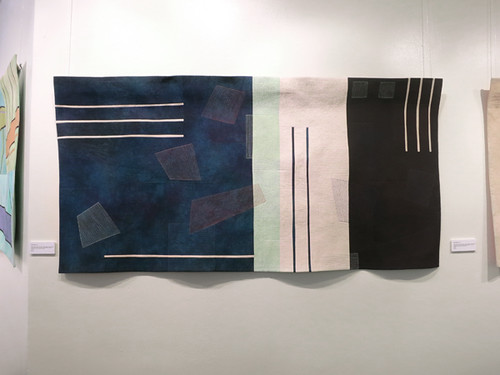 |
| "Structures #115"by Lisa Call |
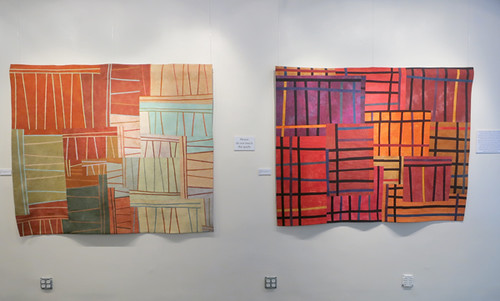 |
| "Structures #72" and "Structures #32"by Lisa Call |
 |
| "Structures # 38" and "Structures #143" by Lisa Call |
The process Lisa Call uses to construct her quilts is extremely deliberate, and each step, from designing the work on the wall to cutting, piecing and quilting, involves no shortcuts. As she says, no strip-piecing is involved - if a line is present in a certain spot it is because she specifically meant for it to be there. I have a lot of respect for this way of working, and I enjoy how different it is from my own approach which favors reacting to a work as it develops in real time over careful planning. One area where Lisa Call and I have a similar style, however, is dyeing! Her way of dyeing is in direct contrast to her approach to construction - she uses no formulas, dyes only one yard of fabric at a time, and embraces the "you get what you get" quality that is the result. Brilliant!
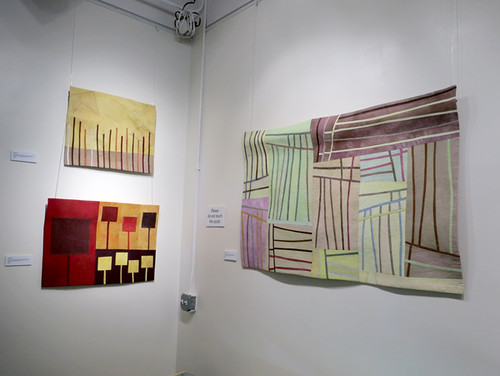 |
| "Dream "37," "Dream #38," and "Structures #97" by Lisa Call |
Two final thoughts from Lisa Call. The first is her answer to the inevitable question of where the distinction is drawn between functional quilting and Art Quilting. Her response to this is simple and struck me as incredibly true. The answer is Intention. She creates her pieces with the idea that they are art. That is their purpose, and it is definitely enough.
The second thing is Call's suggestion of an artist that people interested in her work should also check out. I think this is something I should bring into my posts on artists whenever it's possible - we can learn vast amounts from asking artists we admire who they go to for inspiration. Her suggestion of an artist to check out is the painter Richard Diebenkorn, whose work is also carefully planned and meticulous.
That's it - go check out the show!
Thursday, September 6, 2012
Informative Video on Low Water Immersion Dyeing
I have been doing a fair amount of fiber reactive dyeing recently, and today while trolling YouTube for random video tutorials on the subject, I came across one that quite nicely answers a question I didn't even know I had been meaning to ask. The question, which I realized I had actually been wondering about ever since I started researching low-water immersion dyeing, is: When, exactly, should you add the soda ash fixative to the dye bath, and what will be the result of adding it at various specific points?
It turns out someone else was also wondering about this - Glenda Hopp of http://SoManyColors.net has put together a video in which she explores the effects that can be achieved by adding your soda ash in various ways. I like her no-nonsense approach to dyeing and also to making videos!
It turns out someone else was also wondering about this - Glenda Hopp of http://SoManyColors.net has put together a video in which she explores the effects that can be achieved by adding your soda ash in various ways. I like her no-nonsense approach to dyeing and also to making videos!
Friday, August 31, 2012
My Work, in "High Fiber Under Five" at San Jose Museum of Quilts & Textiles
I am thrilled that five of my quilts have been accepted into the fifth annual "High Fiber Under Five" benefit show for the San Jose Museum of Quilts & Textiles. This show is devoted exclusively to fiber pieces that are priced at $500 or less, and a portion of the proceeds from each sale (between 50% and 100%) will be donated directly to the museum.
The thing I love about this show is that it is specifically geared towards an audience of people who love fiber art but do not necessarily have the disposable funds to become big time collectors.
The show runs from October 20 through November 4 of this year, and if you happen to be in the San Jose area, definitely stop in and pick up some gorgeous and affordable art! Also, let me know what you think of the show!
Here are three of my pieces that will be on view (click on the images to view larger versions on Flickr):
The thing I love about this show is that it is specifically geared towards an audience of people who love fiber art but do not necessarily have the disposable funds to become big time collectors.
The show runs from October 20 through November 4 of this year, and if you happen to be in the San Jose area, definitely stop in and pick up some gorgeous and affordable art! Also, let me know what you think of the show!
Here are three of my pieces that will be on view (click on the images to view larger versions on Flickr):
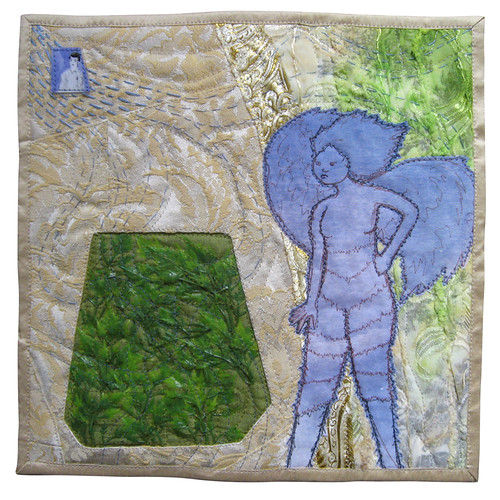 |
| "I Had a Dream Like that Once" |
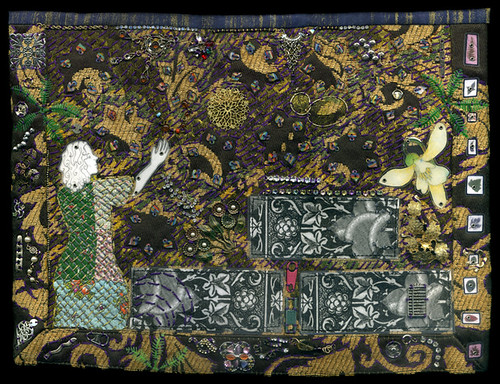 |
| "An Oasis for Orphaned Treasure" |
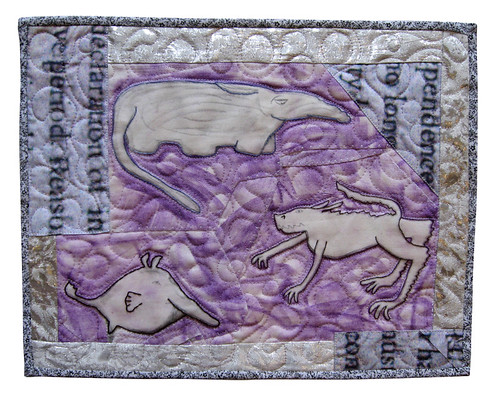 |
| "Fictional Animals: Three New Species Discovered on the Very First Day" |
Thursday, July 19, 2012
My Work, in Quilting Arts Magazine's "From Sketch to Art Quilt" Reader Challenge!
Back in November, when I received the beginning of my Quilting Arts subscription, I was excited to see a reader challenge called "From Sketch to Art Quilt." Exactly the perfect challenge to start with! At the time I was drawing a lot of adorable monsters onto the yellow lined paper pads available at my job, so I decided to turn one of those sketches into the basis for my quilt. I had been having fun for a while already with quilts based on various monsters and "fictional animals."
I scanned the sketch at high resolution and printed it out in cotton in two sections, just for fun. The size of the quilts in this challenge is 8 by 10 inches, so in theory I could have printed the monster all on a single piece of cotton, but I knew I was going to be monoprinting on top of the inkjet, and I wanted to have the option of an image in which the underlying monster drawing appeared to flow seamlessly across the whole quilt while its background broke abruptly into two sections. In the end, the monoprinting that I did, with a Gelli Arts reusable "gelatin" plate, ended up looking similar on both parts of the image. I created a mask for the monster from freezer paper, ironed it into place on each piece of the monster body, then had fun playing around with my Gelli Arts plate. Once my printing was complete, I put the quilt together, with all kinds of added details including embroidery and laminated images.
I was super excited to have my quilt accepted into this particular Reader Challenge, and sent it off to the folks at Quilting Arts, along with the original sketch. They do their magazine photography in-house, and took very good care of my quilt which they eventually returned to me along with a copy of the issue.
Title: "Monster Portrait: Reginald"
Materials: various commercial fabrics, inkjet printed cotton, acrylic paint, laminated imagery, metal eyelets, embroidery floss, buttons
Dimensions: 8" by 10"
Date: 2012
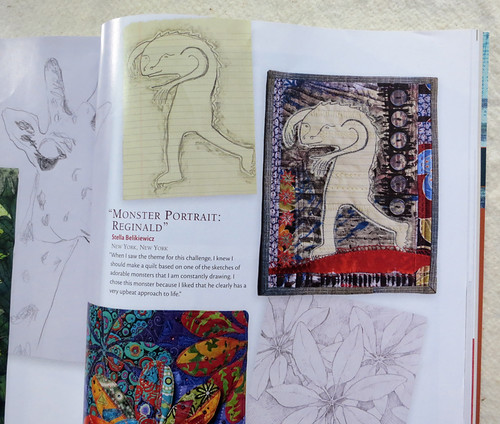 |
| My work, featured in a magazine! |
I scanned the sketch at high resolution and printed it out in cotton in two sections, just for fun. The size of the quilts in this challenge is 8 by 10 inches, so in theory I could have printed the monster all on a single piece of cotton, but I knew I was going to be monoprinting on top of the inkjet, and I wanted to have the option of an image in which the underlying monster drawing appeared to flow seamlessly across the whole quilt while its background broke abruptly into two sections. In the end, the monoprinting that I did, with a Gelli Arts reusable "gelatin" plate, ended up looking similar on both parts of the image. I created a mask for the monster from freezer paper, ironed it into place on each piece of the monster body, then had fun playing around with my Gelli Arts plate. Once my printing was complete, I put the quilt together, with all kinds of added details including embroidery and laminated images.
 |
| Quilting Arts June/July 2012 Issue |
I was super excited to have my quilt accepted into this particular Reader Challenge, and sent it off to the folks at Quilting Arts, along with the original sketch. They do their magazine photography in-house, and took very good care of my quilt which they eventually returned to me along with a copy of the issue.
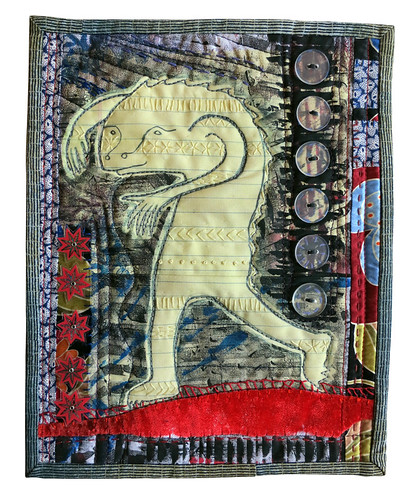 |
| "Monster Portrait: Reginald" |
Title: "Monster Portrait: Reginald"
Materials: various commercial fabrics, inkjet printed cotton, acrylic paint, laminated imagery, metal eyelets, embroidery floss, buttons
Dimensions: 8" by 10"
Date: 2012
Monday, June 18, 2012
New Quilt - "Blue Space #1"
In addition to having sat around nearly finished in a box for at least three years, this quilt has an additional claim to fame. The curlycues cut from mat board that are attached to the center of the quilt have been with me since high school! That's right, in one of my first ever printmaking classes we were assigned to create plates for embossing watercolor paper by cutting imagery into mat board. Several coats of gesso later, it turns out that thing will not only be able to pull a giant number of embossed prints but also survive to be reinvented fourteen years later!
Another fun element of this quilt is the background photographs, which I took of blueberries floating in a bowl of water and then printed onto iron-on transfers. I like that it's obvious what you're looking at but at the same time they seem like they could be something else entirely.
Title: "Blue Space #1"
Materials: half of a dollar store placemat, plastic leaves, metal eyelets, puzzle pieces, plastic dots, prong settings, perle cotton, muslin, iron-on transfers, laminated imagery, mat board, acrylic paint, oil paint stick
Dimensions: 9.5" by 13"
Date: 2012
The little plastic bauble things at the bottom of the photo above are one of the sad disappointments I've had in my search for art materials. I found a big bag of them at a craft store - they're meant to be placed in the bottom of a vase as an attractive way to hold up floral arrangements. They seemed PERFECT for adding small dots of imagery to my quilts, because they're produced by dripping tiny amounts of molten clear plastic onto a surface, which produces basically a little round clear cabochon the perfect size to fit into a 30SS prong setting meant for Swarovski crystals. My method of using these little guys involved using a 3/16" hole punch to make tiny dots of content from magazine pages which I would adhere to the flat side of the little baubles using clear epoxy. I could then attach them anywhere on a quilt using the prong settings. They were gorgeous. If this seems too perfect to be true, that's definitely because it is. The fatal flaw of these little gems, which I did not discover until I had used them in a number of projects, is that they are extraordinarily brittle. Even a slight impact against a hard surface causes them to shatter. It was tragic to give up on this idea, but I refuse to use anything in my art that will randomly shatter!
This piece of mat board with swirly things carved into it is one of those items that I have had for many, many years. I carved the little swirls to make an embossing plate during one of my first ever printmaking classes, way back in high school. The pink around the edge is there because the project in question involved combining the embossing with a silkscreened image, and my idea was to leave a little window in my red ink to accommodate the embossing. Afterward, of course, I couldn't possibly get rid of the mat board with the swirls carved into it - it only took me fifteen years to find a home for it!
Another fun element of this quilt is the background photographs, which I took of blueberries floating in a bowl of water and then printed onto iron-on transfers. I like that it's obvious what you're looking at but at the same time they seem like they could be something else entirely.
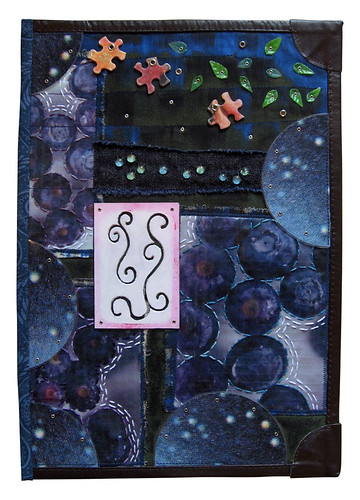 |
| "Blue Space #1" |
Title: "Blue Space #1"
Materials: half of a dollar store placemat, plastic leaves, metal eyelets, puzzle pieces, plastic dots, prong settings, perle cotton, muslin, iron-on transfers, laminated imagery, mat board, acrylic paint, oil paint stick
Dimensions: 9.5" by 13"
Date: 2012
 | |
| Puzzle pieces, iron on transfers, metal eyelets and little plastic bauble thingies that are meant for floral arrangements |
The little plastic bauble things at the bottom of the photo above are one of the sad disappointments I've had in my search for art materials. I found a big bag of them at a craft store - they're meant to be placed in the bottom of a vase as an attractive way to hold up floral arrangements. They seemed PERFECT for adding small dots of imagery to my quilts, because they're produced by dripping tiny amounts of molten clear plastic onto a surface, which produces basically a little round clear cabochon the perfect size to fit into a 30SS prong setting meant for Swarovski crystals. My method of using these little guys involved using a 3/16" hole punch to make tiny dots of content from magazine pages which I would adhere to the flat side of the little baubles using clear epoxy. I could then attach them anywhere on a quilt using the prong settings. They were gorgeous. If this seems too perfect to be true, that's definitely because it is. The fatal flaw of these little gems, which I did not discover until I had used them in a number of projects, is that they are extraordinarily brittle. Even a slight impact against a hard surface causes them to shatter. It was tragic to give up on this idea, but I refuse to use anything in my art that will randomly shatter!
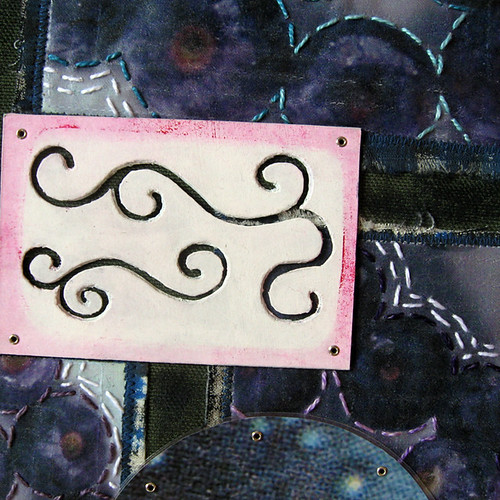 |
| Swirly thing carved into a piece of mat board |
This piece of mat board with swirly things carved into it is one of those items that I have had for many, many years. I carved the little swirls to make an embossing plate during one of my first ever printmaking classes, way back in high school. The pink around the edge is there because the project in question involved combining the embossing with a silkscreened image, and my idea was to leave a little window in my red ink to accommodate the embossing. Afterward, of course, I couldn't possibly get rid of the mat board with the swirls carved into it - it only took me fifteen years to find a home for it!
Tuesday, June 12, 2012
New Quilt: "Map of Regional Attractions #3"
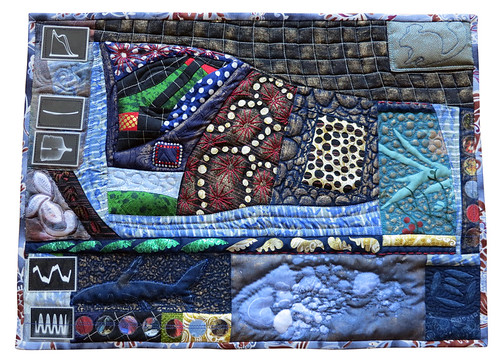 |
| "Map of Regional Attractions #3" |
Title: "Map of Regional Attractions #3"
Materials: cottons & synthetic fabrics, tulle, lace, inkjet printed cotton, oil paint stick, laminated imagery, perle cotton, Swarovski crystals, press-on sequins
Dimensions: 20.5" by 14.75"
Date: 2012
This quilt makes heavy use of oil paint sticks, which I have recently realized are an incredibly powerful tool for adding texture or imagery to a quilt. The shark was made using the paint stick "carbon paper" technique I demonstrated in this post, and other areas have antique gold pigment applied using the tip of my finger onto already quilted areas. This produced a beautiful and dramatic effect that I will definitely have to explore further.
 |
| The shark was created by tracing a drawing on paper with paint stick pigment liberally applied to the back side. |
The graph-y looking images were from a book titled "101 Ways to Use Your Sweep Generator," which was found at a Goodwill in Seattle a million years ago. I had no idea at the time what a Sweep Generator was, and I have to admit, I still have no idea because instead of reading the book like a normal person, I immediately cut out all the fabulous illustrations and laminated them. They've been slowly finding their way into projects ever since.
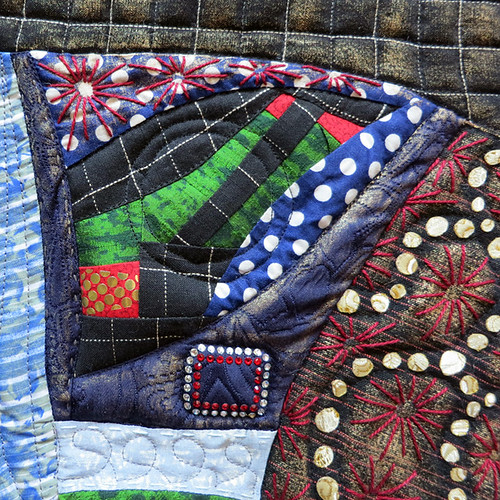 |
| The little rectangle of Swarovski crystals were leftover from a Rockette costume. |
This quilt was mostly completed while my new machine was out for repairs, and so I got to know the old Pfaff again. That thing may be old, but it's still a rock star in my book!
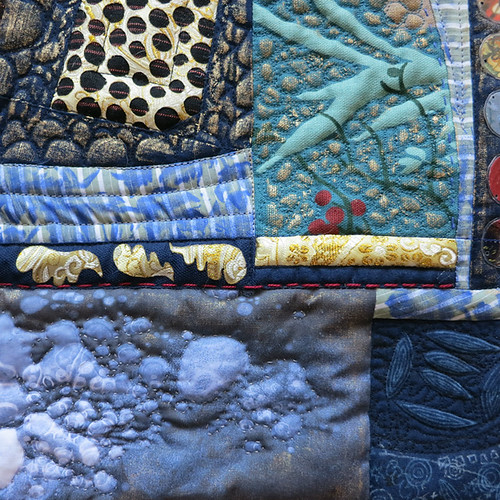 |
| The photograph printed onto cotton at the bottom of the quilt is of the frozen surface of the Harlem Meer in Central Park. I used hand-quilting to accentuate the bubbles captured in the ice. |
One question about this quilt that will just have to be answered by time is whether oil paint stick pigment will remain on fabric without being heat-set. This was the project for which I decided to try out Poly-Fil Hi-Loft batting, which it turns out gets all compressed and useless when you expose it to heat, so I just have to hope all the gold will stay on there. Maybe I'll post a follow-up in ten years!
Thursday, June 7, 2012
Art Show: "Midwest Filipino" by Daniel Ballesteros, presented by Chashama.org
Today, I had one of those wonderful serendipitous New York moments that I personally have too few of because I almost never leave my apartment. I was walking along 37th Street, heading towards the subway, when I spotted a teeny tiny storefront gallery full of what looked like hundreds of miniscule black and white photographs. A sign on the door encouraged me to come in, so I did just that, and I'm so glad I did - this is exactly my kind of art!
All the tiny photos turn out to be the work of Daniel Ballesteros, a photographer originally hailing from St. Louis, Missouri and currently operating in Brooklyn. See the bottom of this post for location and dates!
Ballesteros makes tintypes, a photographic process I did not know much about - Wikipedia describes the process this way: "a photograph made by creating a direct positive on a sheet of iron metal that is blackened by painting, lacquering or enamelling and is used as a support for a collodion photographic emulsion."
The show contains two different presentations for Ballesteros's photographs. The first group are individually mounted to the wall on tiny custom supports that appear to be made from an upside down version of the channeled molding that holds the chalk at the bottom of a blackboard. They're probably no more than 3 by 4 inches, and it is incredibly rewarding to get up close to each one and peer at it to see what is revealed.
The second presentation method involves photographic prints on glass, in series of two or three or many more, held into simple wooden frames using loops of wire. These are incredibly beautiful and mysterious, and there are excellent flaws in the glass or the emulsion that I was particularly drawn to.
I'm just going to quote some big chunks of Ballesteros's website, because his artist statement is well written and informative, and a far cry from the pretentious crap that can be either written after hours of painstaking fruitless labor or, much more easily, created with zero effort using the Arty Bollocks instant artist statement generator. I promise I won't always use all these giant block quotes, but I like Ballesteros's description of his work more than any description I could come up with, and if that makes me lazy, I won't even try to get out of being called that! Anyway, here's some of what he has to say about his series, "Midwest Filipino."
This show is presented by Chashama.org, a non-profit organization that "supports communities by temporarily transforming vacant properties into spaces where artists can flourish." Upcoming events they're putting on include "Bait and Switch," a group show of artists "whose work captures the viewer's attention then pulls the rug out from under them," opening June 22nd right near me in Harlem at 461 West 126th St.
This show, "Midwest Fillipino" by Daniel Ballesteros, will be running at 277 W 37th St, New York, NY through June 11th and you all should check it out - I hear there's going to be a closing party featuring wine and cheese! (I know, the end date is super soon, but I only found out about this show by accident.) If you love tiny things that get better the closer you look, definitely go see this show!
All the tiny photos turn out to be the work of Daniel Ballesteros, a photographer originally hailing from St. Louis, Missouri and currently operating in Brooklyn. See the bottom of this post for location and dates!
Ballesteros makes tintypes, a photographic process I did not know much about - Wikipedia describes the process this way: "a photograph made by creating a direct positive on a sheet of iron metal that is blackened by painting, lacquering or enamelling and is used as a support for a collodion photographic emulsion."
The show contains two different presentations for Ballesteros's photographs. The first group are individually mounted to the wall on tiny custom supports that appear to be made from an upside down version of the channeled molding that holds the chalk at the bottom of a blackboard. They're probably no more than 3 by 4 inches, and it is incredibly rewarding to get up close to each one and peer at it to see what is revealed.
The second presentation method involves photographic prints on glass, in series of two or three or many more, held into simple wooden frames using loops of wire. These are incredibly beautiful and mysterious, and there are excellent flaws in the glass or the emulsion that I was particularly drawn to.
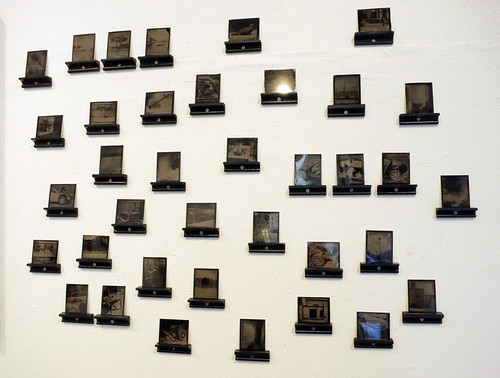 |
| Small individual photographs by Daniel Ballesteros |
I'm just going to quote some big chunks of Ballesteros's website, because his artist statement is well written and informative, and a far cry from the pretentious crap that can be either written after hours of painstaking fruitless labor or, much more easily, created with zero effort using the Arty Bollocks instant artist statement generator. I promise I won't always use all these giant block quotes, but I like Ballesteros's description of his work more than any description I could come up with, and if that makes me lazy, I won't even try to get out of being called that! Anyway, here's some of what he has to say about his series, "Midwest Filipino."
"This project is about my experience as a Filipino American coming from an area of the U.S. with very little Filipino culture, and a family that did what it could to assimilate as best as possible. The first part of the project, addressing the successful assimiliation of my Filipino Grandfather into the U.S., is a series of photographs of the environment and people that helped to shape my identity - without Filipino influence."
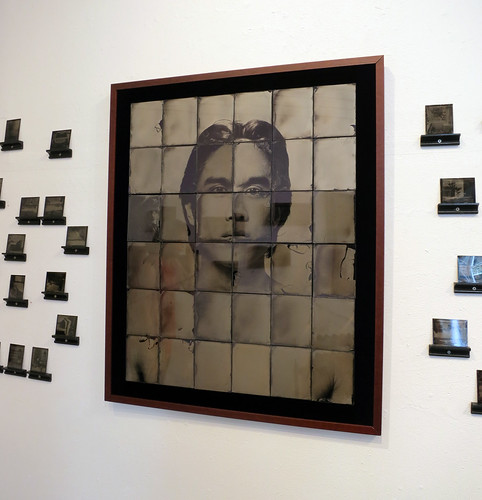 |
| A larger work comprising thirty individually printed photographs on glass |
(continued) "The Midwest is in many ways a perfect backdrop for assimilation stories. It once attracted numerous European immigrants (Dutch, German, French, Italian, and Irish) who filled many midwest neighborhoods along with their countrymen. Over time, those culturally rich communities "Americanized" and lost much of their own identity among the suburban sprawl of tract houses and strip malls that now typify the region."
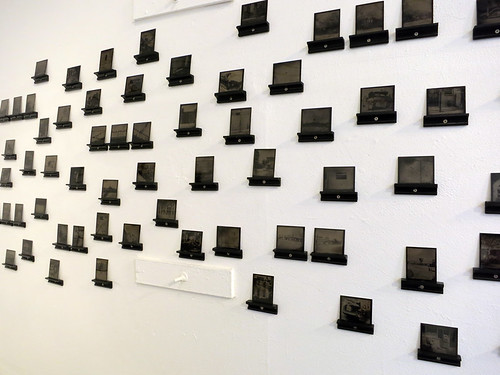 |
| More of the tiny images - I adore the way they work with the weird existing wall features in this gallery space. |
(continued - I added the bold part because I just think this bit is so very cool!) "For this series, the self-portrait of Midwest Filpino, I have made wet plate collodion positive images on both metal and glass from digital snapshots. Once a plate is made, the digital file is then erased, so that one unique collodion plate remains--a single physical token pulled from a digital recording--looking at its expression, its storage abilities that we embrace and pretend to manage. As external hard drives stack up on desktops (virtual and actual), the topic of utility arises, highlighting how helpful modernization really is, and our tendency to save everything (because it is so easy). In my work and life, I see one beautiful aspect of the human memory being its abilitiy to forget things, unconsciously filter out what seems unimportant, reinterpret all that appears to inhibit our progress, whether truly threatening or just perceived as being so. And like this human memory, my pictures are imperfect and flawed, lacking the precise in precise detail. The images for this series are two steps removed from their original scene and decades distanced in regards to process. They are represented in sometimes-cloudy warm monotones. They are small plates that possess a digital time and date stamp to reference their place in multiple eras at once, (both having a common interest in the practice of seeing and recording)."
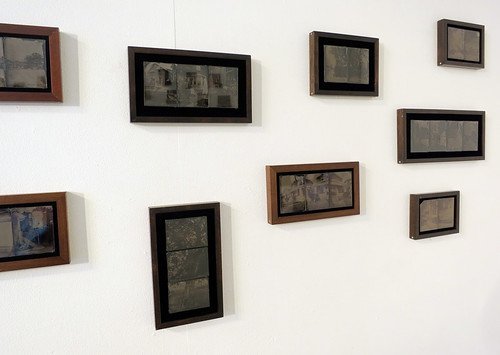 |
| Unfortunately with photography glare can make it hard to capture, but these pieces, composed of two to four small glass plates that make up a larger image, definitely blew me away! |
This show is presented by Chashama.org, a non-profit organization that "supports communities by temporarily transforming vacant properties into spaces where artists can flourish." Upcoming events they're putting on include "Bait and Switch," a group show of artists "whose work captures the viewer's attention then pulls the rug out from under them," opening June 22nd right near me in Harlem at 461 West 126th St.
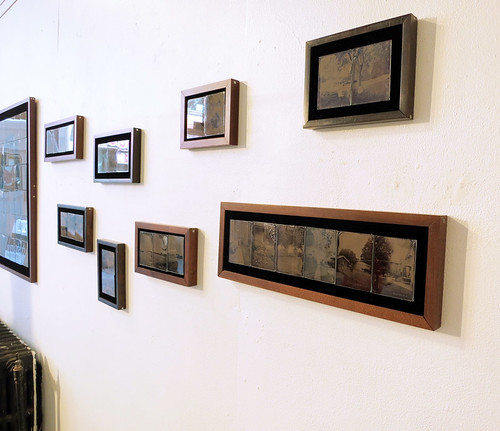 |
| One last shot of the gallery's second wall |
This show, "Midwest Fillipino" by Daniel Ballesteros, will be running at 277 W 37th St, New York, NY through June 11th and you all should check it out - I hear there's going to be a closing party featuring wine and cheese! (I know, the end date is super soon, but I only found out about this show by accident.) If you love tiny things that get better the closer you look, definitely go see this show!
Tuesday, June 5, 2012
Art Show: "Quilts from Nature: Landscapes & Florals" by Lenore Crawford, at The ArtQuilt Gallery in New York
It's that time - The ArtQuilt Gallery has a new show, and once again you all should head over and check it out if you possibly can! Like their last show that I covered on the blog, "Walking Through Time" by Sue Benner, this collection of quilts bursts with intense colors that seem like they can barely be contained!
The new show is called "Quilts from Nature: Landscapes & Florals," and features works by Lenore Crawford. These quilts range from medium to large-ish scale and are created using a combination of fusible raw-edge applique and pieced backgrounds.
Ms. Crawford's ability to combine commercial fabrics with hand painted elements greatly impressed me - from a distance her work seems to flow with perfect smoothness from one fabric type to another. When I got closer I enjoyed the challenge of picking out which elements were commercial fabrics from what must be a very impressive stash, and which elements were individually painted.
The show's wall text states,
The fact that both this show and the previous one featured fused fabric with exposed raw edges, plus the fact that in both cases this technique looked excellent and completely professional, makes me want to try bringing some more raw edges into my own work. In their work Lenore Crawford and Sue Benner use different approaches to how the fabric edges should be secured. In Sue Benner's quilts, the fused fabric was held securely by quilting motifs that existed independently of the shapes in the cut fabric - the quilting anchored the fabric securely by crossing the raw edges repeatedly over the progress of the design. Lenore Crawford's style involves more use of stitching that catches fabric edges by traveling precisely just along the inside of each design element. Both methods look fabulous!
This last quilt, "Grand Poppy," is my favorite piece from the show. In addition to the gorgeous range of colors Ms. Crawford has incorporated into the flower's petals (my photograph seriously does this work NO JUSTICE at all!), the quilt incorporates a beautifully complex background composed of hundreds of tiny pieced squares in an incredible range of colors. Fields of tiny pieced squares have always been on my list of favorite quilt elements!
The new show is called "Quilts from Nature: Landscapes & Florals," and features works by Lenore Crawford. These quilts range from medium to large-ish scale and are created using a combination of fusible raw-edge applique and pieced backgrounds.
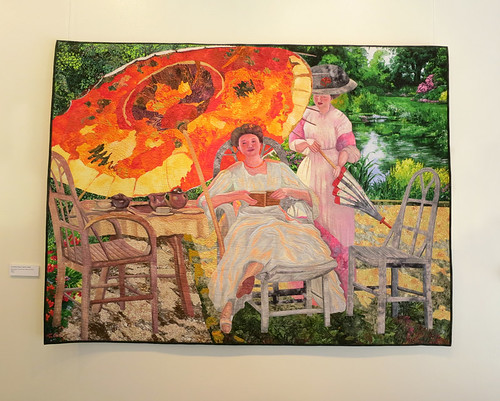 |
| "The Garden Parasol, Fredrick Fesieke" - 2008 |
Ms. Crawford's ability to combine commercial fabrics with hand painted elements greatly impressed me - from a distance her work seems to flow with perfect smoothness from one fabric type to another. When I got closer I enjoyed the challenge of picking out which elements were commercial fabrics from what must be a very impressive stash, and which elements were individually painted.
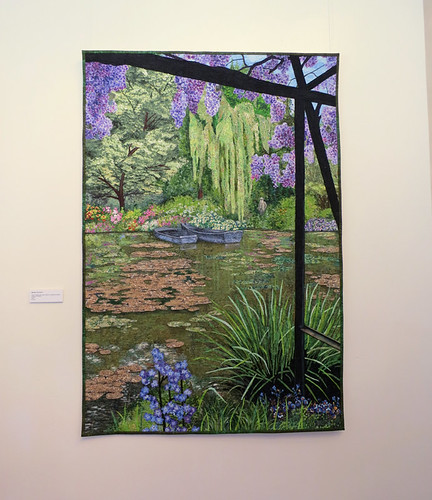 |
| "Monet's Lily Pond" - 2010 |
The part about warmth and vitality completely made sense to me - these quilts were all able to draw me in and hold my attention for a long time in a way that other works featuring the same subject matter of landscapes and floral designs rarely are able to. I enjoy both categories of artwork, but generally do not feel compelled by them when they are depicted in other media."Lenore Crawford's fabric art combines her love of France, especially its architecture and gardens, with her passion for color and realism. Lenore's complementary use of texture and painting provide her works with a warmth and vitality only possible with this unique medium. "
 |
| "Hybrid Lily III" - 2008 |
The fact that both this show and the previous one featured fused fabric with exposed raw edges, plus the fact that in both cases this technique looked excellent and completely professional, makes me want to try bringing some more raw edges into my own work. In their work Lenore Crawford and Sue Benner use different approaches to how the fabric edges should be secured. In Sue Benner's quilts, the fused fabric was held securely by quilting motifs that existed independently of the shapes in the cut fabric - the quilting anchored the fabric securely by crossing the raw edges repeatedly over the progress of the design. Lenore Crawford's style involves more use of stitching that catches fabric edges by traveling precisely just along the inside of each design element. Both methods look fabulous!
 |
| "House of Roses" - 2008 |
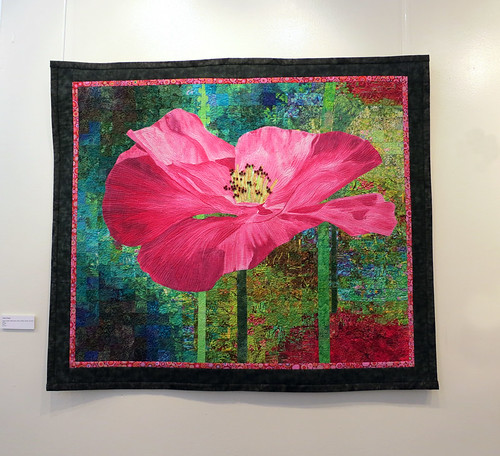 |
| "Grand Poppy" - 2007 |
This last quilt, "Grand Poppy," is my favorite piece from the show. In addition to the gorgeous range of colors Ms. Crawford has incorporated into the flower's petals (my photograph seriously does this work NO JUSTICE at all!), the quilt incorporates a beautifully complex background composed of hundreds of tiny pieced squares in an incredible range of colors. Fields of tiny pieced squares have always been on my list of favorite quilt elements!
Subscribe to:
Comments (Atom)



